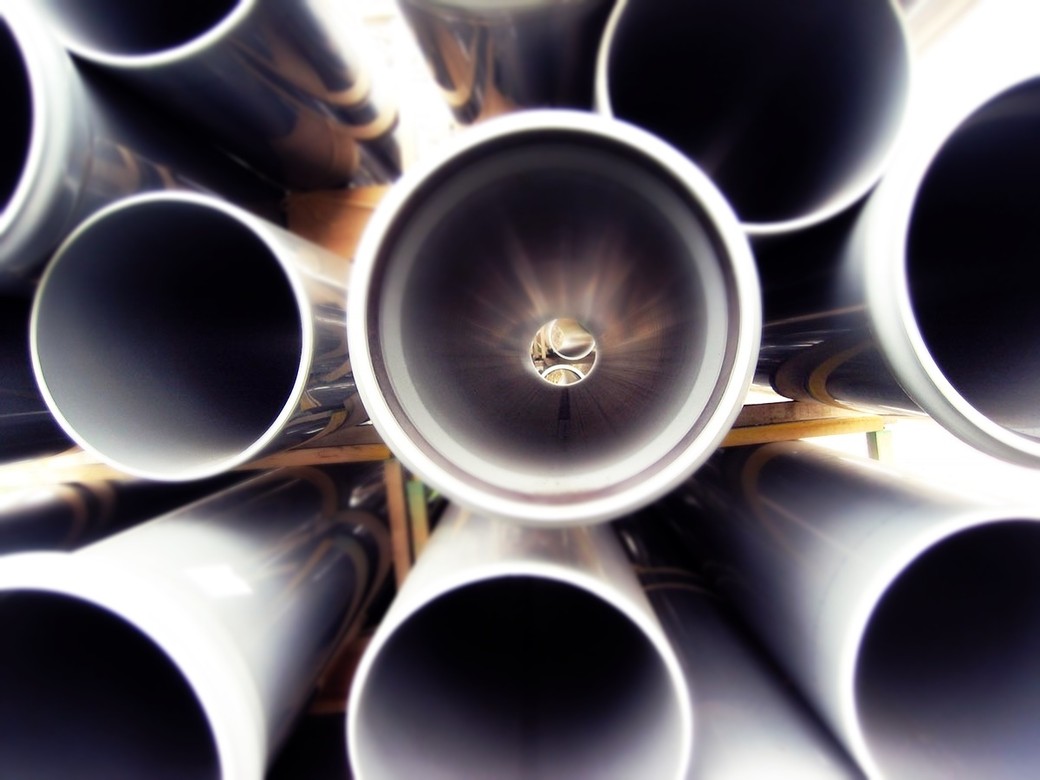
AN OVERVIEW: Pipelines and Progress
Image: wikipedia
Canadian oil and gas production, which represents nearly one- quarter of Canadian exports, is increasing but options to transport the products via cross-continent pipelines have created political controversy.
The arguments centre on increased use of North American energy supply and resources versus the detriments of global warming and potential pollution along the routes.
Energy pipelines used in North America include liquid petroleum pipelines, natural gas pipelines and refined product pipelines which carry gasoline, jet fuel, and home heating fuel; highly volatile liquid (HVL) lines; and carbon dioxide lines. These pipelines are located all over North America.
Gathering lines move petroleum from the wells and are predominantly in Texas, North Dakota, California, New Mexico, Louisiana and Wyoming. Feeder lines move it to transmission lines (also called trunk lines) which are the superhighways of petroleum transportation and move fuel across North America. Natural gas distribution lines are the only lines which go to individual homes and businesses. Highly volatile liquids lines (HVL) transport liquids like butane, propane and ethane which vapourize when exposed to the atmosphere. Carbon dioxide lines are used to enhance oil recovery.
Two proposed new pipelines are hotly debated, Transcanada Pipelines Limited’s Keystone XL and Energy East.
 The Keystone network of energy pipelines is the largest in North America. Upon completion the system will be 3,462 kilometres (2,151 miles), at an anticipated cost of $5.3 billion US. It consists of four main pipeline proposals. Phase one, named the Keystone pipeline, was completed in 2010 and runs from Hardisty, Alberta, to Steele City, Wood River and Patoka. The second phase, the Keystone-Cushing extension, from Steele City to Cushing, Oklahoma was completed in February 2011. These two phases increased supply to refineries in the American Midwest. The third phase, the Keystone Gulf Coast Expansion, opened in January 2014 and broadens the current system capacity to 700,000-barrels per day. The final controversial phase, the Keystone XL, is intended to add capacity to the existing pipeline from Hardisty to Steele City. The northern part would move Canadian and US oil and the southern extension would carry oil to the Gulf Coast.
The Keystone network of energy pipelines is the largest in North America. Upon completion the system will be 3,462 kilometres (2,151 miles), at an anticipated cost of $5.3 billion US. It consists of four main pipeline proposals. Phase one, named the Keystone pipeline, was completed in 2010 and runs from Hardisty, Alberta, to Steele City, Wood River and Patoka. The second phase, the Keystone-Cushing extension, from Steele City to Cushing, Oklahoma was completed in February 2011. These two phases increased supply to refineries in the American Midwest. The third phase, the Keystone Gulf Coast Expansion, opened in January 2014 and broadens the current system capacity to 700,000-barrels per day. The final controversial phase, the Keystone XL, is intended to add capacity to the existing pipeline from Hardisty to Steele City. The northern part would move Canadian and US oil and the southern extension would carry oil to the Gulf Coast.
Proponent Transcanada and supporters of the Keystone XL project promote its potential for increased energy security, reduced dependence on foreign oil, and Canadian-made self- sufficiency regarding the petroleum’s source. Those in favour believe Keystone introduces significant benefits, including potential career opportunities for citizens, increases to the economy, advancement of communication technology, a safer alternative for transporting oil, and essential infrastructure development. Pipelines also reduce the volume of trucks on streets and highways and the amount of explosive material moved by rail.
Independent analysis and Statistics Canada studies suggest an estimated $10 billion (25.3 GDP) increase for the Canadian economy throughout the six-year construction phase. The assessment also forecasts 1,087 additional sustained jobs over forty years.
Proponents also claim increased oil production is not feasible with the current North American pipeline systems. Opponents use this as an argument against the pipeline, because it will cause additional Oil Sands development.
The U.S. Department of State predicts that the pipeline could introduce an additional 27 million additional tons of carbon dioxide to the atmosphere. A 12 to17 per cent increase of greenhouse gas emissions could be released annually should the project unfold according to current proposals.
Opponents to the project include some Aboriginal peoples, farmers, and many environmental organizations, as well as some members of the United States Congress and the US National Resources Defense Council. Their concerns reflect unanswered questions and a lack of trust in the industry. How will the pipelines impact the environment? Will land, safety, and human rights be violated?
TransCanada states it works with both regulators and members of the public to assure public confidence, and is adopting 57 conditions. TransCanada says its representatives speak with American Aboriginal peoples and farmers through a developed integrity management program, in attempts to initiate efforts to reach an agreement to endorse economic and energy increases, while limiting detrimental impacts.
Most pipelines are located underground, with piggybacked above-ground pump stations.
Underground development is viewed as threatening to Aboriginal domains and menacing to land and water. Fears include contamination of groundwater and surface water, pollution with its environmental hazards, and reduced quality of locally caught fish. Pipeline spills or leaks close to crops and residences could be extremely detrimental to farm produce and human health. Opponents also fear possible explosions.
Many Nebraskan farmers are protesting in full force—identifying similar environmental and authentic rights concerns as the First Nations peoples in Canada. As a result the first route proposed by TransCanada through Nebraska over the Ogallala aquifer was changed late in 2012 to reduce potential water contamination and farmland disturbance.
CEO and President of TransCanada Corporation, Russ Girling, has said staffing is the foundation of safety management. He says safety development plans are currently in place, beginning with dedicated 24/7 monitoring of the pipelines, monitored computer screening systems, red flags which alert systems of problems, full investigation of all emergencies, and training staff to react efficiently to any barriers. Reported incidents per miles of pipeline have decreased by 62 per cent since 2001.
Control room technologies and training in place through National Transport Systems Monitoring (NTSM) are supposed to shut down pipeline flow if there are release incidents or malfunctions in the pipeline system. The Common Ground Alliance (CGA) works with industry to develop practices and prevention programs.
TransCanada claims Keystone cannot be compared to other pipelines because of advanced technology, including communication technology consisting of 16,000 sensors on the pipeline itself, which would be refreshed every five seconds and automatic shut-off valves to isolate and depressurize problem areas. TransCanada says the Keystone pipeline is the safest mode of transportation, regardless of the corrosive material being shipped and the associated environmental impacts.
Critics point to the leaks of Keystone, only built in 2010, but the youngest pipeline to receive a Corrective Action Order from US federal pipeline regulators.
Another controversial pipeline is the first of the two major east-west proposals, TransCanada’s Energy
Communications technology consisting of 16 000 sensors on the pipleline itself, which would be refreshed every five seconds.
East pipeline, a proposed $12 billion project. Energy East seeks to convert a portion of an existing natural gas pipe to carry crude oil to Ontario and build a new pipeline through Quebec into New Brunswick.
The second east-west proposal, which is from Enbridge Inc., plans to reverse the flow in an existing pipeline. Line 9B sent imported oil from Montreal to the West. Enbridge and project supporters would prefer to see western Canadian fuel sent to Montreal for refining. A supplementary proposal was named the Alberta-to-the-Pacific pipeline proposal.
Other North American pipeline projects are the Gulf Coast Pipeline Project, the Houston Lateral Project and the proposed Northern Gateway. On one hand, those who endorse the new pipelines argue that economic and energy security is central to Canadian and North American advancement. Job opportunities would be created. On Keystone XL 4,800 people worked on starting the project, and another 5,000 more would be employed to finish. Reliance on oil from the Middle East and Venezuela could be reduced by forty per cent. The pipeline would also enable 830,000 barrels of oil daily to be transported to the Midwest and Gulf Coast—for refining and export.
On the other hand, recent spills, some of which were disastrous, by TransCanada and Enbridge- owned pipelines have hardened the opposition, who demand the economic disadvantages be considered too. Large spills and fires not only have environmental consequences, some of which cannot be undone, but also have a big negative economic impact. The polarization of viewpoints has become entrenched, and claims of corporate bullying tactics and lack of respect for residents in the pipelines’ paths have raised the profiles of the opposition.
US President Barack Obama stated, “The paths towards sustainable energy resources will be long. We cannot resist the transition. We must lead it.” Which direction will this path take?













